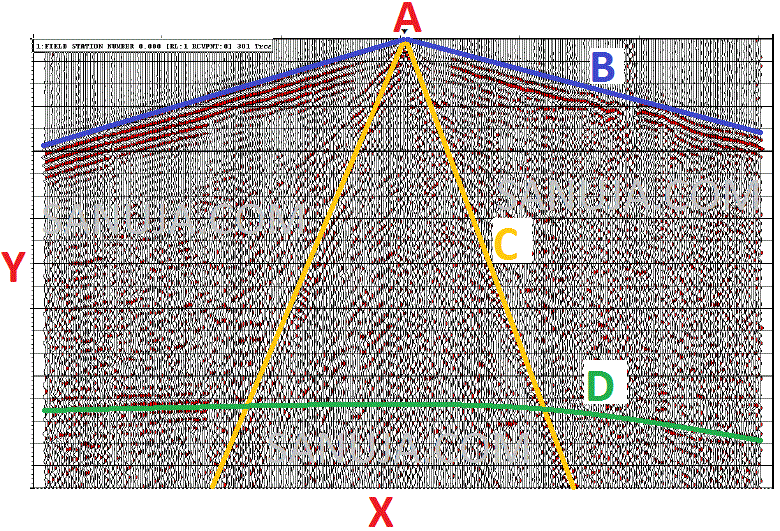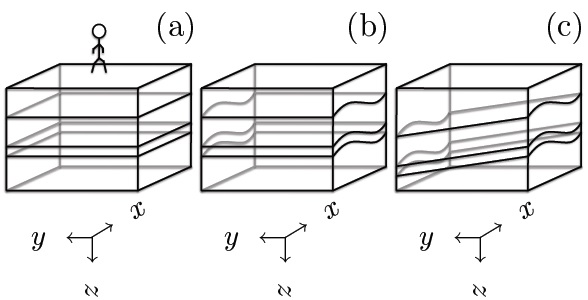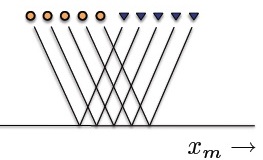Notice
This is the non-interactive basic mode of GOPH 355 questions database for printing or use in case of SQL database failure on main site. All the questions and answers are identical except the order of questions and answers.Please use the interactive version for more up to date materials.
Geophysics (GOPH 355-UCAL) Midterm Exam I
1. A source is also know as…(more than one answer is possible)
A. shot point
B. receiver
C. sensor
D. geophone
2. Inline ONLY experiments are considered to be 2D experiments.
A. True
B. False
3. How do the geophones work?
A. By measuring changes through amp fluctuations.
B. By measuring changes through distance fluctuations.
C. By measuring changes through shock wave fluctuations.
D. By measuring changes through voltage fluctuations.
4. Which side of the Displacement-Time graphs would you color?
A. Negative side
B. Positive side
C. Negative and Positive side.
D. Only when there is a major jolt
5. Sudden changes (jolts) in displacement is known as…
A. traces.
B. spikes.
C. arrivals.
D. peaks.
6. A geophone is also know as…(more than one answer is possible)
A. source.
B. receivers.
C. sensors.
D. shot point.
7. By convention, when representing data depth is always increase upwards.
A. True
B. False
8. In a typical experiment, which direction will have the most readings?
A. inline
B. crossline
C. into the plane
D. out of the plane
9. Which can be used to interpret the Elastic behavior of rocks and sediments? (choose all that apply)
A. Hooke’s Law
B. Gravitational Law
C. Poisson’s ratio
D. Conservation of Energy Principle
10. Generally, modules are another name given for constants.
A. True
B. False
11. Generally, modules are another name given for constants.
A. True
B. False
12. Where is the source position in the shot record (Figure 01)?
A. along B
B. at A
C. along C
D. along D
E. at X
F. at Y
13. The wave propagated through air known as air blast. Where is the air blast in the shot record(Figure 01)?
A. along B
B. at A
C. along C
D. along D
E. at X
F. at Y
14. What is on the x-axis (red X) in Figure 01?
A. Time in seconds
B. Time in milliseconds
C. Distance in meters
D. Depth in meters
15. Direct arrival is indicated with what letter in Figure 01?
A. along B
B. at A
C. along C
D. along D
E. at X
F. at Y
16. On Figure 01, what is indicated by letter D (green line)?
A. Direct arrival
B. Air blast
C. Reflected arrival
D. Ground roll
17. “Every point on a wave-front may be considered a source of secondary spherical wavelets which spread out in the forward direction at the speed of light. The new wave-front is the tangential surface to all of these secondary wavelets.” is the…
A. Snell’s law
B. Fermat’s principle
C. Newton’s first law of waves
D. Huygens’ principle
18. What are the types of seismic sources? (choose ALL that apply)
A. Reflected waves
B. Refracted waves
C. Direct waves
D. Penetrated waves.
E. Deflected waves.
19. Which of the following image represent a data gathered from a 3D seismic experiment (Figure 02)?
Image Credit: Lecture notes, Dr. Kristopher Innanen
A. a
B. b
C. c
D. None of the above
20. On Figure 02, which of the image represent a data gathered from a 2D seismic experiment?
A. a
B. b
C. c
D. None of the above
21. What type of volume will highlight changes in geology only in x-direction and y-direction?
A. 1D volumes
B. 2D volumes
C. 3D volumes
D. 4D volumes
22. Typically what type of direction is well sampled?
A. inline geophones
B. crossline geophones
C. neither since they are interchangeable
23. Traces are analyzed in sets known as groups.
A. True
B. False
24. In seismic analysis, why do we use folds?
A. Folds are important geological events.
B. To reduce noise by increasing the CMP gather stacking.
C. To create events.
D. To increase the covered area.
25. In the following equation, what is represented by xg,yg?
d = d(xg,yg,xs,ys|t)
A. The position of the source.
B. Depth which the ground reflection occurs.
C. The position of the ground refraction.
D. The position of the geophone.
26. When dealing with variable area plotting, the data are recorded as displacement vs time. What is the correct formula for seismic displacement?
A. d = d(xs,ys,xg,yg|t)
B. d = d(xs,ys,xs,ys|t)
C. d = d(xg,yg,xs,ys|t)
D. d = d(xg,yg,xh,yh|t)
E. d = d(xg,yg,xm,ym|t)
F. d = d(xm,ym,xs,ys|t)
27. What profile view is shown on Figure 03?
Image Credit: Lecture notes, Dr. Kristopher Innanen
A. Common Midpoint Gather
B. Common Offset Gather
C. Common Shot Gather
D. Common Receiver Gather
28. Pauli exclusion principle state that the atoms cannot occupy the same state.
A. True
B. False, because it is only applies to particles, not atoms.
C. False, because it is only applied to radioactive atoms.
29. What part of the Distance Between Particles verses Potential Energy graph, the geophysicists are interested in?
A. The lowest point of potential energy.
B. The highest point of potential energy.
C. The non-elastic region.
D. The positive value of potential energy.
30. The wave equation can be solved by a function of…
A. f(ct- x)
B. f(x – c/t)
C. f(x – ct)
D. f(xt – c)
E. f(xt + c)
31. What law/principle have the following tenets:
The wave that starts at s and ends at g goes everywhere first.
But most of what is observed at g follows the path for which the travel time is a minimum.
A. Hook’s law
B. Fermat’s principle
C. Young’s principle
D. Snell’s law
32. Rays in a homogeneous medium are wavy lines.
A. True
B. False
======= END ========
Answers (highlight/copy the text to see the answers!): 1-A, 2-A, 3-D, 4-B, 5-C, 6-B-C, 7-B, 8-A, 9-A-C, 10-A, 11-A, 12-B, 13-C, 14-C, 15-A, 16-C, 17-D, 18-A-B-C, 19-C, 20-B, 21-B, 22-A, 23-B, 24-B, 25-D, 26-C, 27-B, 28-A, 29-A, 30-C, 31-B, 32-B, …
Explanations: 23: trace is analyzed in sets known as gathers; 32: they are straight lines, aka the Snell’s law is valid;


